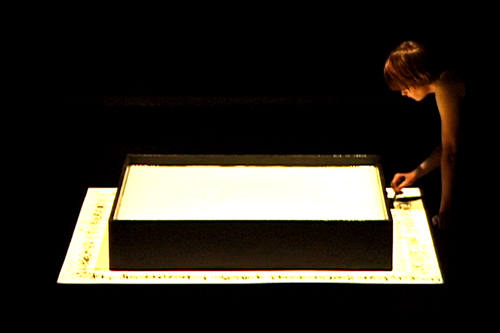|
Intimate drowning
Julia Postle
There are so many rooms in this work; rooms of earth, water, milk and salt.
From the moment we enter from backstage we are stepping into rooms, witnessing
an evocation of emotion through these elements.
There is the image of despair, with a woman siting naked on the floor, arms
around knees, long hair pasted to shoulders, a shower streaming water over
her. We look by stepping up to a strategically placed hole in the wall, take
it in momentarily, and step away for the next in line.
We walk through the stage to the seats of the theatre; taking in other rooms
that are more implied than constructed. A woman is on her hands and knees,
writing furiously the words “I am listening” around the edges of
a square trough filled with milk. We are voyeurs to her distress.
Blocks of ice hang suspended from a metal structure, dripping away throughout
the work, their original form diminishing as they become ever-expanding puddles
of water on the floor.
A mound of earth lies in a corner of the stage. The performer looks at it,
warily, touching it with a toe. Then resentment and irritation seem to set
in as she kicks at it destructively, scattering it across the space.
A rectangular shaft of light is projected on the back wall of the stage and
a solitary figure walks from left to right, painting black circular forms,
first in the light, gradually drifting out of the light’s reach; less
and less contained. She leaves the stage and the door to that room closes.
Salt pours onto the stage in a steady stream from above. A woman is standing
in front of it, oh so slowly moving forwards and backwards within a square
of light. The movement becomes less gentle and more twisted. The salt begins
to take its own form on the floor. Later, another woman stands in the salt,
head bowed, arms outstretched, imploring.
The 2 women stand in a trough of milk, whispering, tenderly embracing and supporting
each other. This scene of comforting grows quite forced, with one pushing against
the other and the milk splashing outside its pristine boundary. The scene closes
with one performer, left to scrub out the words that have framed their struggle; “I
am listening.”
These fragments of the work echo the themes of grief, anger and loneliness;
all emotions that accompany the death of a loved one. The objects Clare Dyson
uses help us to reflect on our own experiences—the mound of earth a grave;
the milk a symbol of the nurturing and care that we put into relationships;
the dripping water perhaps our own transformation on the other side of grief.
With an original score by Damian Barbeler and the reverential music of Zbigniew
Preisner and Meredith Monk filling the space, intimate drowning moves from
solemnity to anguish, with an almost celebratory ending. And the objects are
left to stand alone, forever altered by the performance—pools of water,
splashes of milk, scattered earth and salt.
intimate drowning carries us through a journey of grief and loss with beautiful,
lingering images and riveting moments of movement and stillness that pierce
the soul. It’s another compelling, affecting work by Dyson, and will
stay with me for some time.
intimate drowning, creator/choreographer Clare Dyson
in collaboration with performers Meg Millband, Julia Gray & Carrie
Fowlie, ANU Arts Centre, Australian National University, April 6-13
|

